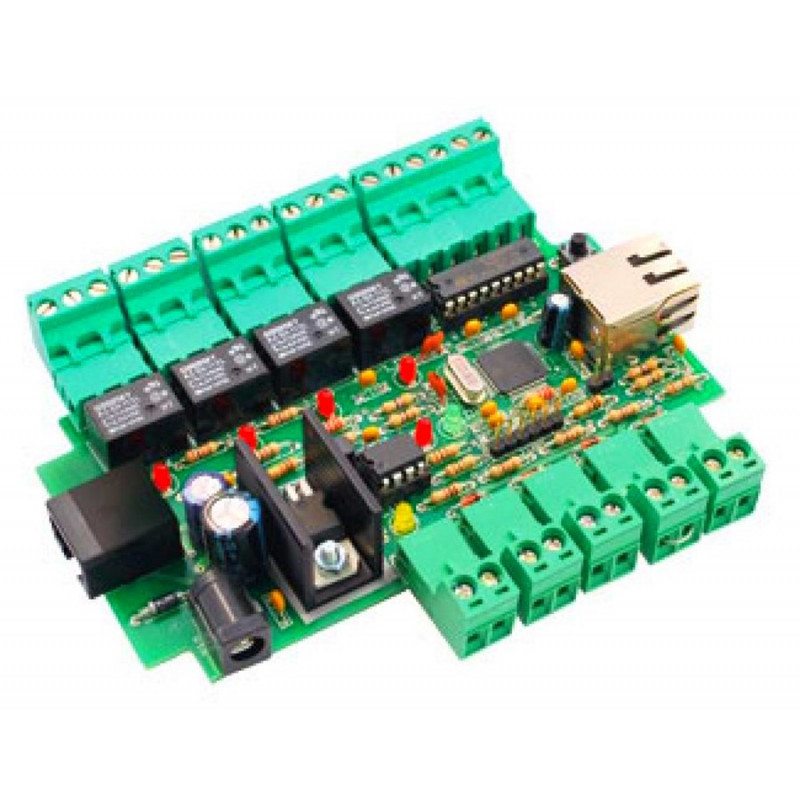- Out-of-Stock






It allows you to control the status of inputs and outputs via LAN via a PC or software, or by purchasing 2 pieces it is possible to create an I / O transfer network on the LAN: the inputs of board 1 are repeated on the outputs of board 2 and vice versa.
 Secure Payments
Secure Payments
Pay safely with Credit Card, PayPal, Amazon Pay or Bank Transfer
 Fast Shipping
Fast Shipping
We ship across Europe and worldwide with UPS, DHL and DPD
 30-Day Easy Return
30-Day Easy Return
You have 30 days from delivery to return the product if you're not satisfied
Attention, the product is ASSEMBLED and TESTED.
Also available in the KIT version or the version mounted onEBAY|MECTRONICA STORE
It allows you to control the status of inputs and outputs via LAN via a PC or software, or by purchasing 2 pieces it is possible to create an I / O transfer network on the LAN: the inputs of board 1 are repeated on the outputs of board 2 and vice versa.
Expandable up to 56 additional inputs or outputs thanks to the appropriate expansion cards that can be purchased in our shop onEBAY|MECTRONICA STORE or via PCF8574A IC based cards such as our IO expander code 3708.The expandability function is reserved for personnel trained in electronics as it requires the correct assignment of addresses and the connection of i2c devices.
|
Device with Ethernet interface for remote digital I / O on 10 Mbit local network and Internet. It allows you to read four logic levels and activate or deactivate users; all remotely and using a single communication line. All signals travel thanks to an interface that implements the ethernet specifications according to the IEEE 802.3 directives. It can work by relying on an existing LAN (Local Area Network); this means that there is no need to pull any dedicated connection line, because LANs are found in both working environments (industries, offices, commercial establishments) and domestic ones. The device is supplied already assembled and tested. It has 4 NO and NC relay outputs (24V / 1A). Power supply: 12 Vdc - dimensions: 125 x 96 x 25 mm. |
|
HOW DOES IT WORK
|
|
To better understand how it works, observe the simple diagram shown in Fig. 1, which shows two E4I4O units called, for simplicity, A and B, both connected to a LAN. Module A reads the status of its inputs and communicates it to B, who will make its outputs assume the states corresponding to those of the inputs associated with them. The operation is symmetrical, therefore also B will do the same towards A: every time one of the inputs is modified, the device will automatically detect the variation and send a data packet on the LAN, addressed to the twin module. The latter "unpacks" it, takes the binary configuration of the remote inputs, and modifies its outputs. Since the communication structure is absolutely equal, i.e. there are no servers or clients, we can then speak of a peer-to-peer connection.
The system allows the configurations of the two modules, the reading of the respective I / O lines, as well as the modification of the inputs, through the browser of any PC connected to the same LAN. Having to communicate using the standard protocols of the TCP / IP stack, our system relies on an HTTP (Hyper Text Transfer Protocol) application and therefore on the TCP transport protocol which, by its nature, gives the communication greater reliability than other possible ones. transport protocols such as UDP. |
|
DOWNLOAD SECTION
|
|
"If a Hardware reset has been performed, the web page contained in the web server will be deleted and it will therefore be necessary to load it again in the module, in this regard download the web page and follow the reset procedure."
|
You might also like